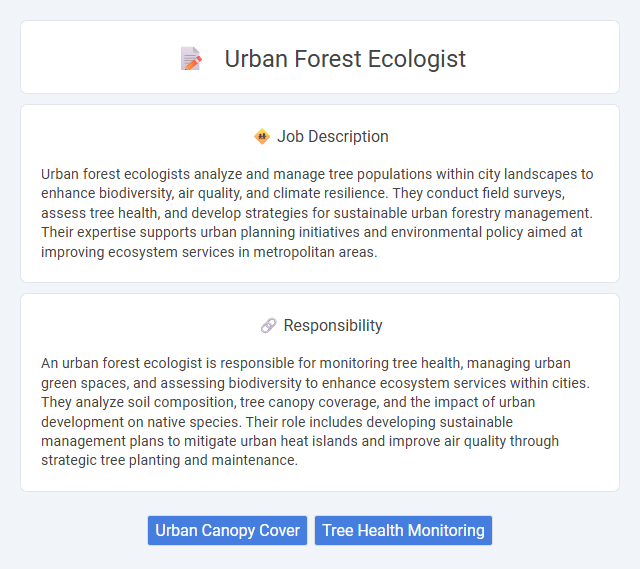
Urban forest ecologists analyze and manage tree populations within city landscapes to enhance biodiversity, air quality, and climate resilience. They conduct field surveys, assess tree health, and develop strategies for sustainable urban forestry management. Their expertise supports urban planning initiatives and environmental policy aimed at improving ecosystem services in metropolitan areas.
Individuals with a strong interest in environmental science and community wellbeing are likely to find urban forest ecologist roles suitable due to the job's focus on monitoring and improving tree health in urban areas. Those comfortable with outdoor fieldwork, data analysis, and collaboration with local governments or communities may have a higher probability of thriving in this position. Conversely, individuals who prefer indoor, solitary work or have limited interest in ecological systems might find the job less fitting for their skills and preferences.
Qualification
Urban forest ecologists require a strong background in ecology, environmental science, or forestry, often demonstrated through a bachelor's or master's degree. Expertise in tree biology, soil science, and urban ecology, combined with skills in GIS mapping, data analysis, and field research, is essential for assessing and managing urban green spaces. Professional certifications like ISA Certified Arborist or Society of American Foresters credentials enhance job prospects and credibility in this specialized field.
Responsibility
An urban forest ecologist is responsible for monitoring tree health, managing urban green spaces, and assessing biodiversity to enhance ecosystem services within cities. They analyze soil composition, tree canopy coverage, and the impact of urban development on native species. Their role includes developing sustainable management plans to mitigate urban heat islands and improve air quality through strategic tree planting and maintenance.
Benefit
An urban forest ecologist likely contributes to improving air quality and mitigating urban heat islands by managing and studying tree populations within cities. Their work probably enhances biodiversity and supports ecosystem services that benefit community health and well-being. It is probable that their expertise aids in urban planning decisions to promote sustainable and resilient green spaces.
Challenge
The role of an urban forest ecologist likely involves navigating complex challenges such as managing biodiversity in densely populated areas and mitigating the impacts of climate change on urban tree populations. It is probable that these professionals face difficulties related to balancing urban development with ecological preservation and adapting strategies to diverse urban environments. Addressing threats like invasive species and pollution may also be significant components of the job's challenge.
Career Advancement
Urban forest ecologists have significant career advancement opportunities by specializing in ecosystem management, urban planning, and environmental policy. Expertise in GIS technology and data analysis enhances prospects for leadership roles in municipal agencies, environmental consulting firms, and research institutions. Developing skills in community engagement and sustainable urban forestry practices can lead to positions such as project manager, senior ecologist, or policy advisor.
Key Terms
Urban Canopy Cover
An Urban Forest Ecologist specializing in Urban Canopy Cover analyzes the density and distribution of trees in city landscapes to enhance ecological benefits and mitigate urban heat islands. This role involves mapping tree cover, assessing species diversity, and recommending strategies for increasing green infrastructure to improve air quality and biodiversity. Expertise in remote sensing technologies and GIS software is essential for accurately measuring and monitoring urban forest canopy changes over time.
Tree Health Monitoring
Urban forest ecologists specializing in tree health monitoring assess the vitality of trees within city landscapes using advanced tools like remote sensing and GIS mapping. They analyze soil conditions, pest infestations, and environmental stressors to identify threats and develop management plans promoting urban tree resilience. Their work supports biodiversity, improves air quality, and mitigates urban heat island effects through strategic preservation and planting of healthy trees.
 kuljobs.com
kuljobs.com